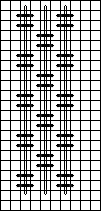
In the background of my alpaca sheep you can find layered stitches. These make fantastic ways to solve the dyelot problem.
What Are Layered Stitches?
A layered stitch is any stitch where some stitches cover other stitches, allowing some of the lower layer of stitches to show through. While there are many stitches that are made in layers, the term generally refers to two groups of stitches.

Tied Stitches, above, have a second layer of stitches going over a stitch. Many Cross Stitches are tied.itch the tie can gather up the stitch, as in Wheat Stitch, or just sits on top of other stitches, as in the stitch pictured above.

Laid work, or Tramme, puts down lines or a grid of thread in the bottom layer. This long stitches are then tied down in a regular pattern. Laid work almost always leaves some of the canvas uncovered. For this reason laid stitches often do not work on unpainted canvases.
Making Laid Work Stitches
When you have a colored area an uneven amounts of your two dyelots, think about using these kind of stitches. Use the smaller dyelot for the bottom, or laid, stitches. These stitches will go the length or width of the canvas in one stitch. This means you will need to use a frame when making laid stitches.
Although you can make these stitches in the usual way, I often use the “economy” method, starting a second stitch at the same end as the previous stitch ended. If you use this method, move from stitch to stitch either behind other stitches or in the unstitched margins of your work.
Once a laid stitch has been made, use your other dyelot to make the tying stitches. Depending on the final result, these stitches can be dense or thinly scattered.
Depending on the laid and tying stitch patterns you can stitch these areas in different ways:
- Make all laid stitches first. If your laid stitches are a grid, you must make them all before tying the grid down.
- Make and tie you pattern row by row.If your tying stitches fall into holes covered by later laid stitches, you must use this method.
Many patterns do not fit into either of these groups, as is the case with Junipero. These stitches can be stitched with either method.
Why Use Laid Work
Because laid work combines open canvas with multiple layers of stitches, they can work really well as backgrounds. They are also superb when you want a feeling or crewel embroidery or Jacobean designs.
They always have a lovely depth to them because the canvas color will look different from the stitch color. If you take advantage of this by combining two dyelots with these stitches you get a richer pattern.
In my sheep, the darker dyelot is used for the laid stitches. The difference is very clear when seen up close. Looking at the piece from a distance, that dark color melts into the colored canvas. It isn’t seen as much as felt by giving this a lovely texture.
Once again a problem, two thread dyelots, is solved by the application of a technique that turns the problem into an opportunity to use a lovely stitch.
About Janet M Perry
Janet Perry is the Internet's leading authority on needlepoint. She designs, teaches and writes, getting raves from her fans for her innovative techniques, extensive knowledge and generous teaching style. A leading writer of stitch guides, she blogs here and lives on an island in the northeast corner of the SF Bay with her family

Leave a Reply